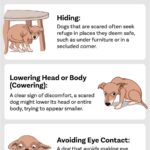What Does Dog Ear Position Mean
Dog Ear Position: What It Says About Your Canine Companion
Dogs are truly man’s best friend. They have a unique ability to communicate with humans, whether it’s through barks, whines, or body language. One of the most notable ways dogs communicate is through their ear positions. A dog’s ears can tell us a lot about how they’re feeling and what they’re thinking.
So, what does dog ear position mean? Let’s dive in and explore this fascinating topic.
Understanding Ear Anatomy
Before we get into the different ear positions, it’s important to understand a bit about dog ear anatomy. Dogs have three types of ear shapes: erect, drop, and semi-erect. Breeds like German Shepherds and Siberian Huskies have erect ears that stand up straight. On the other hand, breeds like Basset Hounds and Cocker Spaniels have droopy ears that hang down low. Lastly, some breeds like Doberman Pinschers have semi-erect ears that stand up but also flop over at the tips.
In addition to their shape, dogs’ ears are also incredibly sensitive. They contain numerous muscles and blood vessels that allow them to move in many directions and pick up even the slightest sound.
Now that we’ve covered some basics let’s dive into what your dog’s ear position might mean.
Ear Positions And Their Meanings
1. Erect Ears
When a dog’s ears are standing tall, it typically means they’re alert and focused on something specific. This could be anything from hearing a strange noise to seeing something interesting across the room. In general, when a dog has erect ears, they’re paying attention.
2. Forward Ears
A slight variation on erect ears is forward ears. This position occurs when a dog’s ears are still standing tall but are tilted slightly forward. This usually indicates curiosity or interest in something new or exciting. If your dog’s ears are forward, they’re likely exploring their surroundings and trying to learn more about the world.
3. Relaxed Ears
When a dog’s ears are in a relaxed position, it generally means they’re feeling calm and content. This is the standard position for many breeds with droopy ears, such as Basset Hounds or Bloodhounds. If your dog’s ears are relaxed, they’re likely feeling comfortable and secure in their environment.
4. One-Up, One-Down
Sometimes you might notice that your dog has one ear up and one ear down. This could mean many things, but typically it indicates uncertainty or indecision. Your dog might be trying to figure out what to do next, which can lead to an asymmetric ear position.
5. Backward Ears
If your dog’s ears are slicked back against their head, it usually means they’re feeling submissive or scared. This is a defensive position that dogs take when they feel threatened or uncomfortable. You might see this position if there’s a loud noise or if your dog encounters a new person or animal that makes them nervous.
6. Flattened Ears
Similar to backward ears, flattened ears indicate fear or anxiety in dogs. This position occurs when a dog presses their ears flat against their head to protect themselves from potential danger. If your dog’s ears are flattened, try to identify the source of their stress and help them feel safe again.
7. Raised Hackles
Finally, raised hackles aren’t technically an ear position but are worth mentioning because they often occur in conjunction with specific ear positions. Raised hackles refer to the hair on a dog’s back standing up straight, indicating agitation or aggression.
When Do Ear Positions Change?
It’s essential to remember that ear positions aren’t static; they can change depending on how your dog feels or what’s happening around them. A dog with erect ears might suddenly flatten them if they hear a loud noise, for example. Similarly, a relaxed dog might perk up their ears if they see something interesting.
It’s also worth noting that ear positions can vary depending on breed and individual. Some breeds are naturally more expressive with their ears than others, so it’s essential to understand your specific dog’s body language.
Conclusion
In conclusion, understanding dog ear positions is an integral part of communicating with your furry friend. By paying attention to their ears, you can get a sense of how they’re feeling and what they might need from you. Remember to take into account other body language cues as well, such as tail position or overall posture.
So next time you’re snuggling with your pup, take a moment to observe their ear position. Who knows? You might learn something new about your faithful companion!



